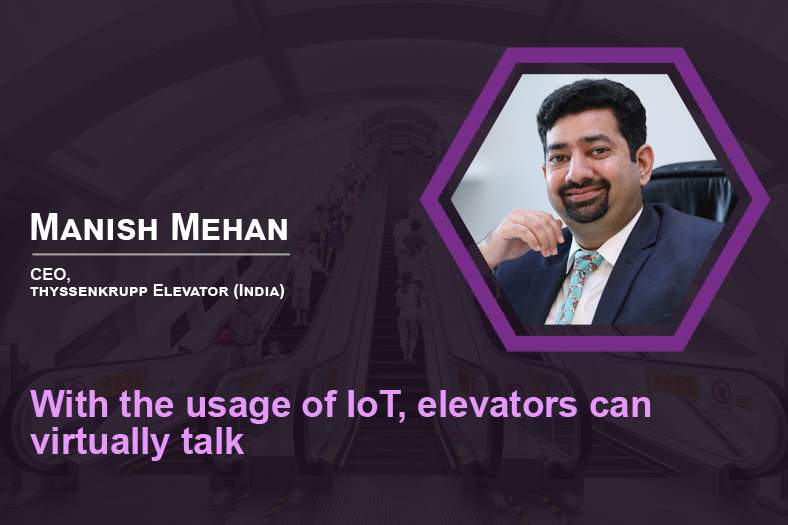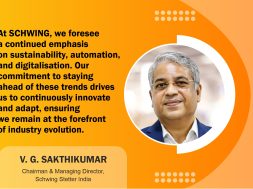With the usage of IoT, elevators can virtually talk

Digitalization has opened new avenues for the elevator industry, the future elevator systems will be more energy-efficient and safe says Manish Mehan, CEO, thyssenkrupp Elevator (India).

As we embrace IoT and smart building technology, how is the elevator and escalator industry catching up in terms of technology and innovation?
Major innovations and advancements such as the launch of smart elevators, rope-less elevator- MULTI, AI, and Internet of Things, extended reality technology have changed the overall face of the elevator industry. It has made vertical transport easy and smart in the past few years. It is an exciting time for the elevator industry. As the technology evolves, the elevators, their maintenance, their upgradation will also evolve simultaneously. The future of elevator systems will be more energy-efficient and safe.
Digitalization has opened new avenues for the industry, and this era brings innovations that changed the industry significantly. With the usage of IoT, elevators can virtually talk to us, tell us when they need help, and even advise technicians on the cause and solution in combination with AI and machine learning. So, it can be fixed before customers even realize there’s an issue. This proactive customer service is all about the ability to understand customers ’ needs and address them before they grow because downtime of an elevator is likely to block many people’s mobility, especially in mid or high-rise buildings, which can cause a significant delay in work.
Having said that, smart service solutions like TK Elevator’s, MAX can detect and predict every issue. These remote diagnostic and troubleshooting properties of smart lifts save a lot of time and cost. Also, with VR, the technicians don’t even have to go to the site for testing the problem. Proactive repair makes the lifts extremely time-efficient.
Likewise as high-rises turn into super structures what are the dedicated products which are coming up in the elevator space?
There is growing demand for high-speed, high-capacity, smart elevators that can carry many passengers at once, safely and comfortably, particularly in super high-rise office buildings, commercial complexes, and other large-scale facilities.
One popular smart elevator feature is destination selection control (DSC), for which passengers enter their destination floor on input terminals in the lift lobby. Each passenger is then assigned to a specific lift which would take him or her to the respective destination floor in the shortest time with a minimal number of intermediate stops. Compared to conventional elevator control systems, DSC increases passenger handling capacity by up to 30%, minimizes passengers’ travel times to their destination and reduces crowding in lift lobbies. DSC also allows for much more flexibility in elevator grouping, lift core layouts and overall building design.”
For example, TWIN, our fast and energy-efficient innovative elevator system, comes equipped with intelligent traffic control, which optimizes traffic automatically and reduces empty runs. This state-of-the-art system has two cabs running independently in the same shaft, each with its own counterweight, safety and drive equipment. With reduced shaft core space and construction costs, the TWIN elevator system offers the most flexible elevator solution with an eco-conscious heart.
TK Elevator, MULTI, was introduced with innovation as a key objective in mind to cater for the needs of modern architectural designs. MULTI is a breakthrough technology which harnesses the power of linear motor technology to move multiple cars in a single shaft both vertically and horizontally, without the limitation of traditional rope-driven systems.

Innovative building designs have also created a niche market for horizontal elevators, can you elucidate on horizontal elevators and its uses?
Lifts are now moving horizontally with the launch of TK Elevator’s “MULTI”. MULTI is the world’s first rope-free elevator that moves multiple cars in a single shaft vertically and horizontally, and reduces elevators’ footprint by up to 50 percent while increasing passenger throughput.
MULTI is set to revolutionize tall building construction. With MULTI’s rope-free system, architects and developers are no longer restricted in their designs by concerns about elevator shaft height and vertical alignment. MULTI opens the door to design possibilities in all directions.
From the aesthetics of the commercial and home elevator cars to the durability and sustainability of the elevator systems, everything is evolving and getting better. Therefore, we can expect smart lifts and elevators to become even more popular in the future.
It won’t be long before elevators recognize passengers and predict where they are going based on machine learning. In the future, when people ride elevators, streaming services and content in the cabin will not only be adapted to the time of the day but specially catered to individual passengers.
What are some of the most important parameters to be kept in mind when selecting an elevator for a high-rise?
Given that the elevator core forms the building’s load-bearing structure and such factors are determined early in the design process, the right choices have to be made first time round. There are few if any opportunities to correct mistakes later. This demands logistical and elevator planning insight, extensive expertise and experience, and the application of correct safety margins. Which is why, builders, architects and elevator manufacturers need to work together to develop vertical transportation systems that are attuned with the building design, are operationally safe and efficient. A well-engineered design will take into consideration occupancy level of the building, elevator cabin capacity, factor in waiting times, cost-effectiveness, energy consumption, and consider ways to optimize space in the building. It is the improvements in elevator safety, comfort, speed, quality, space efficiency, and performance that have become challenges as well as opportunities in vertical transportation. There should be safer and faster solutions for access and destination control, information communication and equipment monitoring.

Nowadays high-rises are also coming up in cities where there is a power deficit, in such areas what alternative arrangements should be made, so that people don’t get stuck in elevators in case of a power cut?
Effective and proven safety features ensure the safety of the elevator as well that of the rider. For example:
- Automatic rescue device protects passengers from being trapped inside elevators in case of unexpected power outages by taking them to the nearest floor.
- Over-speed governors prevent speeding in both directions, thereby improving passenger safety.
- The gradual activation of progressive safety gear stops the elevator in a safe way in case of a safety activation, thus reducing passengers’ risk of tripping.
- Full-height infrared curtains render invisible safety nets of beams across elevator entrances and ensure that passengers are not hit by the leading edges of doors.
- Safe door systems prevent doors from opening when the elevator is in between the floors.
One of the best solutions in this regard would be the advanced Occupant Evacuation Operation (OEO) enabled elevators, which have been designed and installed by TK Elevator. In contrast to conventional elevators, OEO elevators are able to operate during an emergency, facilitating a faster and more efficient evacuation by combining the use of stairwells and elevators and better accommodating those whose mobility is restricted. OEO elevators are built with safeguards that protect against water, heat and smoke from getting into the elevator lobby or hoistway. In the event of a power outage, these elevators can run on backup power.
30
Cookie Consent
We use cookies to personalize your experience. By continuing to visit this website you agree to our Terms & Conditions, Privacy Policy and Cookie Policy.









